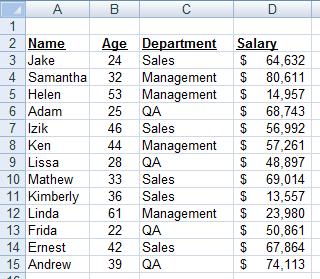SUMIF function
※ Download: Use of sumif in excel
And still, we say that Excel SUMIF can be used to sum values with multiple criteria. It is used to determine which cells to add. A question mark matches any one character and an asterisk matches any sequence of characters.

For formulas to show results, select them, press F2, and then press Enter. However, since we are giving multiple criteria first we need to enter curly brackets to include our criteria.

SUMIF function - The IF function is another favorite tool that lets you see whether or not a particular data point meets a specified condition, including dates, numbers, and text. What you want is to find out a sum of amounts relating to a given fruit and supplier, e.

As everyone knows, Microsoft Excel provides an array of functions to perform various calculations with data. A few articles ago, we explored and , which are designed for counting cells based on a single condition and several conditions, respectively. Last week we covered that adds values meeting the specified criteria. Now it's time to go over the plural version of SUMIF - Excel SUMIFS that allows summing values by multiple criteria. We discussed its syntax in detail in the , so let me give you just a quick summary now. As you see, the syntax of the Excel SUMIF function allows for one condition only. And still, we say that Excel SUMIF can be used to sum values with multiple criteria. How can that be? By adding the results of several SUMIF functions and by using SUMIF formulas with array criteria, as demonstrated in the examples that follow. The SUMIFS function was introduced in Excel 2007, so you can use it in all modern versions of Excel 2016, 2013, 2010 and 2007. This can be a single cell, a range of cells or a named range. Only cells with numbers are summed; blank and text values are ignored. You can supply the criteria in the form of a number, logical expression, cell reference, text or another Excel function. The SUMIFS function works with AND logic, meaning that a cell in the sum range is summed only if it meets all of the specified criteria all the criteria are true for that cell. And now, let's have a look at the Excel SUMIFS formula with two conditions. Suppose, you have a table listing the consignments of fruit from different suppliers. You have the fruit names in column A, suppliers' names in column B, and quantity in column C. What you want is to find out a sum of amounts relating to a given fruit and supplier, e. When you're learning something new, it's always a good idea to start with simple things. To use them correctly, you need to clearly understand what these two functions have in common and in what way they are different. While the common part is clear - similar destination and parameters - the differences are not so obvious, though very essential. The order of arguments In Excel SUMIF and SUMIFS functions, the order of arguments is different. At first sight, it may seem that Microsoft deliberately complicates the learning curve for its users. However, upon a closer look, you will see the reasoning behind it. If you omit it, no problem, your SUMIF formula will sum values in the range first parameter. Alright, enough strategy i. In the same manner, you can use Excel SUMIFS with multiple criteria expressed by numbers, dates, logical expressions, and other Excel functions. Excel SUMIFS with comparison operators In our fruit suppliers table, suppose, you want to sum all deliveries by Mike with Qty. We covered all possible in detail when discussing Excel SUMIF function, the same operators can be used in SUMIFS criteria. For example, the following formula with return the sum of all values in cells C2:C9 that are greater than or equal to 200 and less than or equal to 300. Suppose, you have an order date in column B, delivery date in column C and Qty. How do you find the total of products that have not been delivered yet? That is, you want to know the sum of values corresponding to non-empty cells in column B and empty cells in column C. But what if you need to sum values with multiple OR criteria, i. SUMIF + SUMIF The simplest solution is to sum the results returned by several SUMIF functions. But a SUMIF + SUMIF formula may grow up enormously if you want to sum values with multiple OR conditions. In this case, a better approach is using an array criteria argument in the SUMIF function. Let's examine this approach now. You can start by listing all of your conditions separated by commas and then enclose the resulting comma-separated list in curly brackets, which is technically called an array. The array argument consisting of 3 values forces your SUMIF formula to return three separate results, but since we write the formula in a single cell, it would return the first result only - i. This approach works with numbers as well as with text values. For instance, if instead of the suppliers' names in column C, you had supplier IDs like 1, 2, 3 etc. The formulas will be very similar to what we've just discussed. As usual, an example might help to illustrate the point better. In our table of fruit suppliers, let's add the Delivery Date column E and find the total quantity delivered by Mike, John and Pete in October. To convert these Boolean values to 1's and 0's, you use the double minus sign, which is technically called the double unary operator. The second unary negates the values, i. I hope the above explanation makes sense. And even if it doesn't, just remember this rule of thumb - use the double unary operator -- when you are using comparison operators in your SUMPRODUCT formulas. Using Excel SUM in array formulas As you remember, Microsoft implemented the SUMIFS function in Excel 2007. If someone still uses Excel 2003, 2000 or earlier, you will have to use a SUM array formula to add values with multiple AND criteria. Naturally, this approach works in modern versions of Excel 2013 - 2007 too, and can be deemed an old-fashioned counterpart of the SUMIFS function. In the discussed above, you have already used array arguments, but an array formula is something different. When entering any array formula, you must press Ctrl + Shift + Enter. Once you do this, your formula gets enclosed in curly braces, which is a visual indication that an array formula is entered correctly. If you try typing the braces manually, your formula will be converted to a text string, and it won't work. SUM array formulas in modern Excel versions Even in modern versions of Excel 2016, 2013, 2010 or 2007, the power of the SUM function should not be underestimated. The SUM array formula is not simply gymnastics of the mind, but has a practical value, as demonstrated in the following example. Suppose, you have two columns, B and C, and you need to count how many times column C is greater than column B, when a value in column C is greater or equal to 10. Think about it in another way : Suppose, you have the orders list like shown in the screenshot below and you want to know how many products have not been delivered in full by a given date. But hopefully, they have helped pointing you in the right direction and now you can sum values in your Excel workbooks no matter how many intricate conditions you have to consider. I need to add a column of cells but only those that are listed as a specific month ie 'January', 'Feb' etc. Then I need these January amounts to be bought back into another sheet and for them to match in the corresponding cell. Month AccountCode Amount Aug-16 21011077 4290 Sep-16 21011077 4070 Oct-16 21011077 5500 Nov-16 21011077 5500 Dec-16 21011077 4730 Jan-17 21011077 5230 Feb-17 21011077 5990 A. Code Description Aug-16 Sep-16 21011077 Visa Letter Fee Unique Data is Account code, but sum is arrive based on month. My problem is i want to use cell number insted of text how is it possible. Hello i have a question. I was looking for a function that add votes or number based on criteria. I was thinking perhaps sumif was the right function but apparently i was wrong. I could really use some help. For more details and info, please, feel free to check another article out -. Can you give me a formula or a logic with whcih I can just change the reference formula get changed as per the reference in that cell. But, the array is specified in a different cell i. How do I reference that cell with criteria in the sumif statement. Can we mix with criteria rang also, as below. I hope this explain. Thank you, Darshan Hello Ablebits team! I have an interesting one for you. Hello, I need a formula that sums two numbers cell a4+a5 if it is greater than 1 and less than 35. Also, I need the same for the difference of the same cells and criteria with absolute value. Lastly, for each formula where the sum or difference is outside the range, I need the cell to blank no zeroes. Do you have any work around suggestions. Essentially I want the value in the cell to change based on what the user selects in the drop down box and the column that is calculated as the sum varies upon their selection. In your original example, if one was wanting to find out how many apples were not sold by Pete, is there a way to do this without telling the formula to calculate Mike and John and Sally's contributions? I have a spreadsheet where I need to calculate nationalities and I want to exclude only certain nationalities for my total. Is there a way to do this without having to input all of the nationalities I want into the formula? The SUMIFS with array formula works really well for the nationalities I now need to exclude from my final cells. Feel free to check out to learn why it is used and when in Excel. Hello, I have a similar formula, but needs to look at two cells to see if they have values or not. If one of them has a number i need to take AP9 minus R9. I'm trying to sum up Quantities based on date range. Regards Eddie Hello, For me to understand the problem better, please send me a small sample workbook with your source data and the result you expect to get to. Please don't worry if you have confidential information there, we never disclose the data we get from our customers and delete it as soon as the problem is resolved. Please also don't forget to include the link to this comment into your email. I'll look into your task and try to help. Hello, For me to understand the problem better, please send me a small sample workbook with your source data and the result you expect to get to. Please don't worry if you have confidential information there, we never disclose the data we get from our customers and delete it as soon as the problem is resolved. Please also don't forget to include the link to this comment into your email. I'll look into your task and try to help. Hi, I am trying to SUMIF the following: Channel, Product and Price Under channel column I have different criteria: agent, google, organic, etc. I want to sum all google leads for the various products. This is what I am doing but it is not summing correctly. Can you help, please? Hope something works out for you. Ruth Hello, please can someone help me? I have 2 sheets, one with the current sales by location and the other sheet exactly the same but without figures. I basically need to model it for different scenarios. This is how it works in my head but not in reality. C3,'Project Sales month only'! Thanks in advance Hi Svetlana Cheusheva, Hope you are doing good..... I have couple of question on Sum formula. Thanks in advance Mahaboob I would like to sum the Expected Payment column if the date in the Payment Due Date column is a date in 2018. The works great for multiple if there are only one or two NOTS, but there are several 'not wanted' and only 2 wanted. Does the 'or' criteria need to be first? Thank you for any insight. QUESTION Rubber Material Qty1 Cushion Gum Qty2 LL215-128 11. I need a formula that will total the 'Sex' and 'Race' columns for the gender and race details. The single criteria in the 'Sex' column will be either M or F. The 'Race' criteria will be a single identifier for the race. This seems to be a common problem but I cannot make it work. Thanks for any help. How to calculate Total sales of Google and Costco customer in North East region??? Thanks in advance Savo I am having problems with my SUMIFS. I need to bring the Invoice Amount from two different worksheets over to my main sheet, but I only want them if they match my GL Code and my Monthly Date. The top one I can at least get in without error, but doesn't give me results. Thanks for any assistance, Tracey What expression do I need to use, to do the following for +100 different criteria, that counts up all quantities in the different criteria's. I have just changed the date from cell in which date is mentioned in same format.... The presence of a comma is of no interest to me; if a comma were in a cell alone it could happen I want that ignored so I don't think a pure wildcard would work ie if ANY text in cell K10, divide P10 in half. Any help very gratefully received! I aced indexing and array formulas this morning so I'm sure I can ace this too. Each month has for to five weeks. I want the formula to add data in each months for all weeks in the month but up to the current week. I did the formula below.
With a little creativity, anyone can combine the ideas of comparison operators with or even other functions to develop some useful solutions to complex problems within data. Firstly, we added the SUM function before adding SUMIFS. The order of arguments In Excel SUMIF and SUMIFS functions, the order of arguments is different. Learn editing, formatting, navigation, ribbon, paste special, data manipulation, formula and cell editing, and other shortucts. While the common part is clear - similar destination and parameters - the differences are not so obvious, though very essential. The SUMIFS function works with AND logic, meaning that a cell in the sum range is summed only if it meets all of the specified criteria all the criteria are true for that cell. We covered all possible in detail when discussing Excel SUMIF function, the same operators can be used in SUMIFS criteria.














